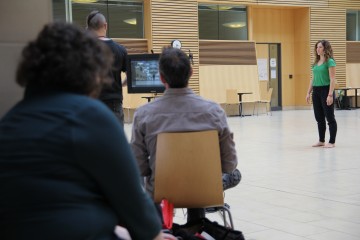The human brain is beautiful in its complexity. But that complexity can be overwhelming for medical students who have nine weeks to reach an understanding of an organ that philosophers and scientist have spent centuries ruminating on. This can cause “neurophobia” – the fear of learning about the brain and nervous system.
This year, MedIT helped Dr. Claudia Krebs mitigate neurophobia by highlighting the beauty of the human brain and making its complexity less daunting for her neuroanatomy students.

Dancers were one of the creative methods used to
demonstrate instructional concepts in videos.
Supported by a grant from UBC’s Flexible Learning Initiative, Dr. Krebs and MedIT’s Educational Technology team created a student-centred “flipped classroom” for her Brain and Behaviour block. In a flipped classroom model, the time spent in the physical classroom is no longer dedicated to the traditional lecture-style transmission of information – that happens before the students arrive, using videos and interactive online modules. Students are able to use these tools to learn at their own pace by pausing and rewinding videos, or by going through online modules as many times as necessary. The classroom (or Gross Anatomy Lab, in this case) then becomes a venue for applied learning, problem solving, and critical thinking.
Dr. Krebs still provides lectures and demonstrates dissections through her leading role in nine videos that provide the “big picture” for core neuroanatomy concepts. The team spent five days creating the videos in the Life Sciences Centre atrium and Gross Anatomy Lab filming with a full production crew and a RED 4K digital camera.
Prior to filming, hours were spent in the planning phase. The Educational Technology team guided Dr. Krebs through the process of storytelling, refining the video scripts to make them more effective with each iteration. Various instructional concepts were discussed, such as the use of dancers to demonstrate how two structures of the brain function to control movement. Dr. Krebs sought ways to use the 1950’s watercolours of Nan Cheney, close friend of Emily Carr and the Faculty of Medicine’s first medical illustrator, which ultimately influenced the style of the videos and the 16 interactive online modules.
When the flipped Brain and Behaviour block launched in January its success was immediately apparent. Dr. Krebs has had students stop her in the Life Sciences Centre atrium to tell her how impressed they were with the videos. She won the Year 2 Teaching Excellence Award for her work. However, the true success, in Dr. Kreb’s words, is that the students “felt supported in their learning.”
Through this project, MedIT is helping the Faculty of Medicine and UBC lead in the realm of transformative learning; making learners and educators proud as the bar is continually set higher.
Related: